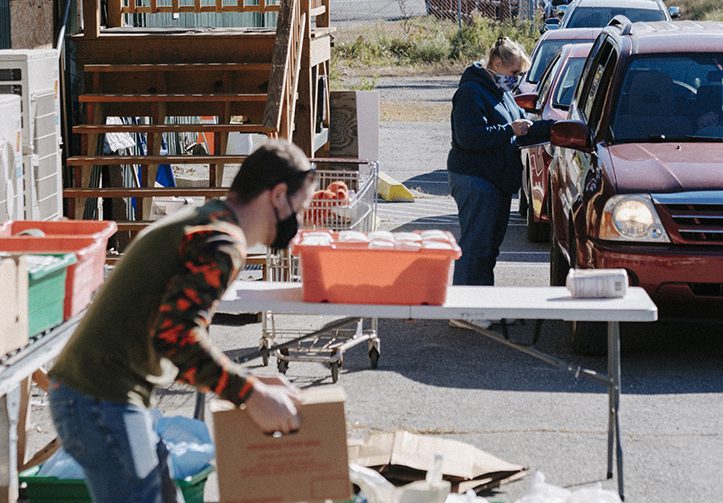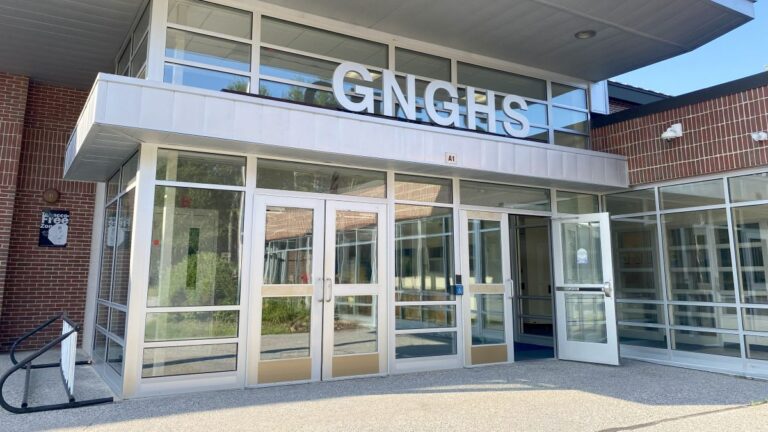On a sunny September morning in Dover-Foxcroft, more than 50 cars stretched from the Piscataquis Regional Food Center three blocks down North Street an hour before a food distribution event was to begin.
Parked along the shoulder, with their engines off and windows rolled down, people from all over Piscataquis County patiently waited to receive apples, oranges, potatoes, frozen meat and canned goods. Some would still be waiting two hours later, with more lining up behind them. Most who came through in the morning appeared older than 60 and many said they were on social security or disability assistance.
Russell Lablanc, a retired millworker, drove one of the 152 cars that waited in line that day. Lablanc, 75, said he knew about the distribution events before the COVID-19 pandemic but pride had kept him away.
He is one of the many new faces at the Dover-Foxcroft Area Food Cupboard, which has seen the number of families it serves increase by more than 50 percent since the start of the pandemic. The food cupboard operates out of the Piscataquis Regional Food Center.
“It’s sad that things are the way they are,” Lablanc said. “You work hard all your life, then it’s all gone when you should be enjoying it.”
As Mainers enter the ninth month of a pandemic that has ravaged the national economy and left nearly 23 million Americans still unemployed, families and organizations are preparing for anticipated increases in demand for food and heat assistance in the coming winter. Meanwhile, Maine’s COVID-19 cases are spiking again, breaking the one-day record for new cases four days in a row with 184 reported on Nov. 6.
And while inequitable access to those services predated the pandemic, so did grassroots efforts to right that imbalance.
Hunger before a pandemic
The economic fallout from the pandemic could strain Maine’s food assistance systems, which already were grappling with the high hunger rates. Private donations and expanded government programs have lessened the impact of the pandemic, but officials wonder whether those efforts can last through the winter.
In 2018, two years before the pandemic, Maine had the highest food insecurity rate in New England and the 12th-highest rate in the nation, according to a study from the left-leaning Maine Center for Economic Policy. And 28 percent of households headed by Mainers of color were food-insecure — more than twice the rate of white, non-Hispanic households. Non-white Mainers make up 7 percent of the population.
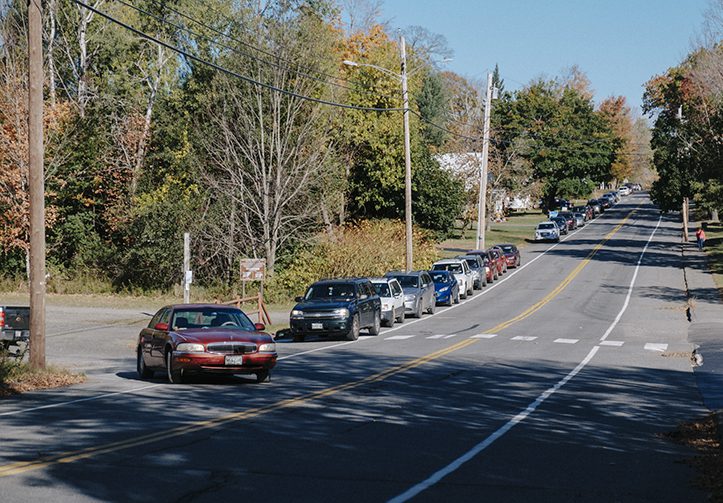
Studies have linked hunger to social problems including chronic poverty, lower academic achievement, and physical and mental health outcomes, said James Myall, a policy analyst with the economic think tank.
“It really keeps people trapped in that generational poverty,” said Kristen Miale, president of the Good Shepherd Food Bank, which coordinates distribution with more than 400 food pantries, soup kitchens, shelters and schools across the state.
Maine’s rate of hunger was below the national average but started creeping up during the 2008 Great Recession and now is higher than the national average, according to the U.S. Department of Agriculture. Miale attributed rising food insecurity to the loss of a “considerable” number of middle-class jobs over the past two decades.
Even as the economy recovered, the jobs that returned offered lower wages, fewer benefits and less scheduling flexibility, she said. Food banks saw an increase in patrons who were employed — a new phenomenon over the last decade.
RELATED: Running on empty
Also, Mainers earn less than the national average but spend more of their income on essentials such as health care, housing, utilities and transportation, Myall said. Many services cost more in Maine and as a result, crowd out money that could be spent on groceries.
“And now with (COVID-19) hitting, all of these issues are just exacerbated,” Miale said. “The first people who are laid off are often those in lower-wage jobs … so it’s just made all of these issues all the more compounded.”
While assistance is available, there was a large gap in access to services for immigrants and Mainers of color long before COVID-19, said Mufalo Chitam, executive director of the Maine Immigrants’ Rights Coalition.
With (COVID-19) hitting, all of these issues are just exacerbated. The first people who are laid off are often those in lower-wage jobs … so it’s just made all of these issues all the more compounded.”
— Kristen Miale, president of Good Shepherd Food Bank
Immigrants can have difficulty transferring their credentials when they move to the U.S. and may end up in lower-wage jobs, Myall said. Program requirements can become barriers for recent immigrants who try to access safety-net services. And Mainers of color who aren’t immigrants still face systemic challenges such as discrimination based on their resume and smaller wage increases.
“In general, a lot of that stuff adds up to those folks having lower incomes than they should because of a lot of these systemic problems, and that makes them more vulnerable to food insecurity,” Myall said.
Even support systems like food pantries can be a barrier for immigrants, many of whom don’t drive and thus have to get rides or walk, Chitam said. In normal times this means they can only take as much food as they can carry. During the pandemic, the situation is worse because they have greater exposure to COVID-19.
“You add (COVID-19 and) it becomes a challenge of where folks have to expose themselves, either transporting someone or to get food,” Chitam said. “They have to go out more times, thereby exposing themselves to this community transmission. So that’s the big concern.”
A surge in demand, but not as large as expected
Yvonne Brackett, 75, was in one of the roughly 115 cars to stop by a food distribution event at the York County Shelters Program in early September. She has been retired for a decade but is thinking about returning to work to help her nine children and 18 grandchildren.
“I didn’t think I’d have to go back to work, but to help my kids I will,” Brackett said. “They’re my life.”

Michael Ouellette, coordinator for the Alfred food pantry, said the number of people it serves has increased more than 50 percent since the pandemic began.
The pandemic, which has caused widespread unemployment due to business closures, prompted a 50 percent spike in demand for food assistance across the state, according to monthly surveys of partner pantries, Miale said. The initial surge was largely due to people across socioeconomic classes hoarding food from grocery stores, she said. There were two points this spring — one week in April and one in May — when Good Shepherd could not buy canned vegetables, soup or other nonperishable food. Instead the organization distributed $850,000 worth of Hannaford gift cards.
After Congress passed a $2.2 trillion relief package that expanded government assistance programs like food stamps and unemployment insurance, the need dropped again. It has hovered around a 25 percent increase since about June, she said, but there are signs the need is picking up again. In a normal year, a 25 percent increase would be “staggering,” Miale said, but it’s not as bad as it could have been.
“If things start to get worse again, they’re going to have to pass another spending bill because that’s really what saved us this spring,” Miale said.
In a normal year, Good Shepherd distributes about 25 million meals. It expects to end the fiscal year next June at 32 million meals — a 28 percent increase.
The attendance at food banks has varied significantly across the state, which Miale believes could be tied to how much individual pantries expanded their hours and services during the pandemic.
Rather than seeing the same people more often, pantries report seeing an increase in the number of people: “So it’s not necessarily new need. It’s need that wasn’t met before,” Miale said.
RELATED: Farming helps reduce food insecurity among Somali Bantu community in Lewiston-Auburn
Miale said she’s heard from partner pantries that some of their regulars said they didn’t need the pantry for the first time thanks to the extension of the Supplemental Nutrition Assistance Program, or SNAP.
Nationally, the SNAP program grew 17 percent with more than 6 million new enrollees in the first three months of the pandemic, according to analysis from the New York Times. Despite previous attempts to cut eligibility, President Trump expanded monthly benefits by 40 percent in April.
In January, right before the pandemic, about 154,000 Mainers were enrolled in food stamps, according to the U.S. Department of Agriculture. According to the latest published estimates, that number rose to 173,000 in April. The average benefit in Maine is about $1 per person per meal, according to the nonpartisan research institute Center on Budget and Policy Priorities.
For every meal the food bank provides, SNAP typically provides more than seven.
“So what we’ve also seen in the pandemic is that when SNAP is properly funded at the levels that it needs to be, people are food secure and they no longer need the food pantry,” Miale said. “And that is a far more effective and dignified way for somebody to have food access.”
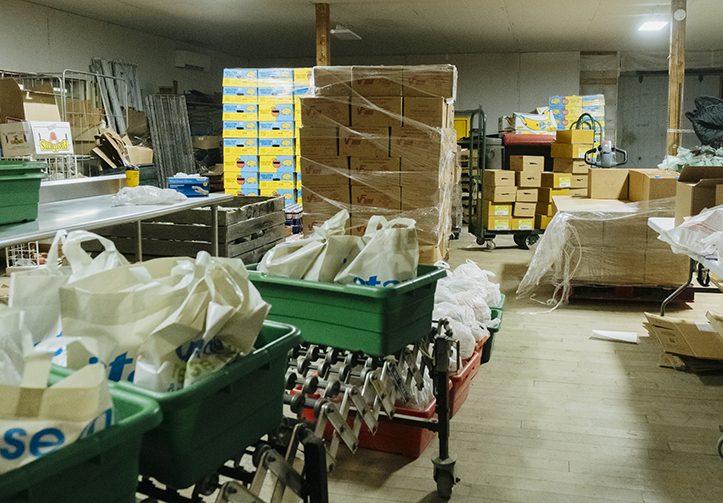
Individual generosity has helped Good Shepherd keep up with increased demand, but it’s unclear if that’s sustainable. Good Shepherd experienced a 50 percent increase in funds during the pandemic, entirely from donations. The organization’s budget, typically around $12 million, will likely end the fiscal year in June just under $18 million, Miale said.
“That’s another one of our concerns: Mainers have been unbelievably generous. If this continues on, how long can they afford to be that generous?” Miale said. “It’s been amazing that they’ve been able to, but Maine is not a rich state. It’s not the Rockefellers who are giving us all this money. It’s regular Mainers.”
Erin Callaway, executive director of the Piscataquis Regional Food Center, said the federal government needs to do more to address hunger. The current system is “inadequate” and pushes the responsibility of helping people meet basic needs onto communities and nonprofits, she said. These organizations are shouldering the burden while the government puts restrictions, red tape and qualifications on their efforts.
We grow up trying to fend for ourselves. I see it a lot in our communities where … it’s hard for (people) to ask for help because they were brought up to take care of your own and get through it.”
— Michael Ouellette, coordinator of the York County Shelters Program’s food pantry
“I don’t want to sound like the government is doing nothing, but it’s not enough,” Callaway said. “What it boils down to is that hunger is hunger. It’s been going on and getting worse year after year — not just in Piscataquis County, not just in Maine but across the country.”
The pandemic has brought awareness to the problem and prompted recent legislation, she said, “but it’s not necessarily led to any wholesale changes that are really going to improve the system for the long haul.”
Ouellette, with York County Shelter Programs, said the “grin-and-bear-it” attitude in Maine sometimes creates a stigma around asking for help.
“We grow up trying to fend for ourselves,” Ouellette said. “I see it a lot in our communities where a lot of people, it’s hard for them to ask for help because they were brought up to take care of your own and get through it.”
Denise Clark, who runs a weekly meal kitchen at Curtis Lake Church in nearby Sanford, said she’s worried about her town coming out of the economic hardships.
“I see it dwindling down to nothing,” she said. “As we dive deeper in, economically, I don’t see us coming out of this very soon. I hate to be so glum but people are drowning so deep.”
Heading into the winter
As temperatures begin to drop, Mainers are beginning to worry about how to keep their homes warm.
But, despite national economic hardship with millions of Americans unemployed, there has been an 11 percent decrease in the number of applications for heating assistance this year. As of Nov. 3, MaineHousing had received 17,688 applications — down from 20,000 during roughly the same time period last year.
Spokeswoman Cara Courchesne cautioned that it’s early in the program year, which began in August, so it’s difficult to draw conclusions from the numbers. She pointed to a number of coronavirus-related challenges this year that could explain the decrease. Many of the community agencies that receive the applications had to close their doors to the public during the pandemic, complicating the workflow process. And program managers were stretched thin administering both the heating assistance and rent relief programs this fall.
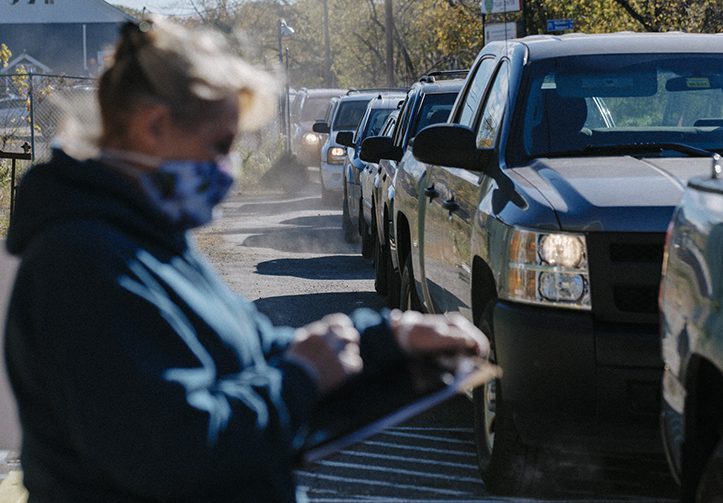
There are signs that the need could be higher than the numbers suggest. Some community agencies are booking application interviews as far out as March and the portion of applicants that are deemed eligible has increased 35 percent this year, likely reflecting both heightened need and awareness of the program, Courchesne said.
MaineHousing already has received a large number of applications for the most recent rent relief program, which opened on Nov. 2. While it’s too early for MaineHousing to release numbers, Courchesne said, “Early indications are definitely suggesting that there’s a significant need.”
Jason Parent, executive director/CEO of Aroostook County Action Program (ACAP), said his organization often sees a spike in demand for emergency fuel assistance in October because applicants don’t start receiving their benefits until around Thanksgiving.
Parent thinks it could be worse this year based on what he saw with an earlier rental assistance program launched in August that provided up to $1,000 for three months of rent. The rent could be used in the coming months or retroactively for three months of missed rent. More than half of the applications ACAP received were for retroactive rental assistance, indicating people are going into the coldest and most expensive time of the year already behind on living expenses, Parent said.
ACAP has received fewer calls for emergency fuel assistance this year. Parent believes it’s because many households had left-over assistance from expanded programs this spring, the fall has been unusually warm and oil prices have remained low.
I’m fearful of what (the winter will) mean for our community because we’re going into it with our social service system, and to an extent our health care system … frayed and exhausted from running what has clearly been a seven-month marathon and has really no end in sight.”
— Jason Parent, executive director of Aroostook County Community Action Program
But the calls started to pick up in the last week with Aroostook County receiving its first snowfalls, he said.
“I would say that we’re holding our own in (the fuel assistance) area, and still concerned about what is going to come depending on the severity of the winter season,” Parent said.
About 40,000 Maine households typically receive heating assistance and about 25 percent of households are income eligible, according to MaineHousing. That’s higher than Connecticut (19 percent), Massachusetts (19 percent), New Hampshire (21 percent) and Rhode Island (22 percent), but below Vermont (45 percent). Nationally, about 20 percent of households participate in the federal Low Income Home Energy Assistance Program.
Most households receive between $600 and $1,000 in assistance for a program year, but this can vary and is calculated based on factors including household size, income and energy use.
The federal government released $36.3 million for energy assistance in Maine on Friday, with $1.3 million earmarked for tribes and tribal organizations. MaineHousing previously received an additional $2.8 million of federal funding for the energy assistance program to deal with the impact of the pandemic through September 2021.
Many people who are struggling aren’t used to accessing services, according to Courchesne and Parent.
ACAP, which normally serves about 14,000 people annually, recorded 1,000 new customers between March 16 and June 1, most of whom had never needed the agency’s assistance, Parent said.
“And almost every one of them called, scared and not knowing what services and systems — or how to navigate them — are available for them,” Parent said.
ACAP received a little more than $400,000 in federal coronavirus relief funding through September 2022 to continue its efforts. It also received “an outpouring” of $140,000 in donations since the start of the pandemic, which was used primarily for food assistance. But Parent worries whether that kind of generosity is sustainable.
“I’m calling this our COVID-19 winter,” Parent said. “I’m fearful of what it’s going to mean for our community because we’re going into it with our social service system, and to an extent our health care system, all of those things frayed and exhausted from running what has clearly been a seven-month marathon and has really no end in sight.”
COVID-19 as ‘magnifying glass’ on existing inequality, solutions
The coronavirus brought attention to existing inequalities, but Chitam, of the Maine Immigrants’ Rights Coalition, says that doesn’t mean the problem will be solved overnight.
“When it comes to issues for people of color, change means changing systems,” said Chitam. Whether it’s food insecurity, education or health care, communities of color are “already coming in behind and trying to play catch up.”
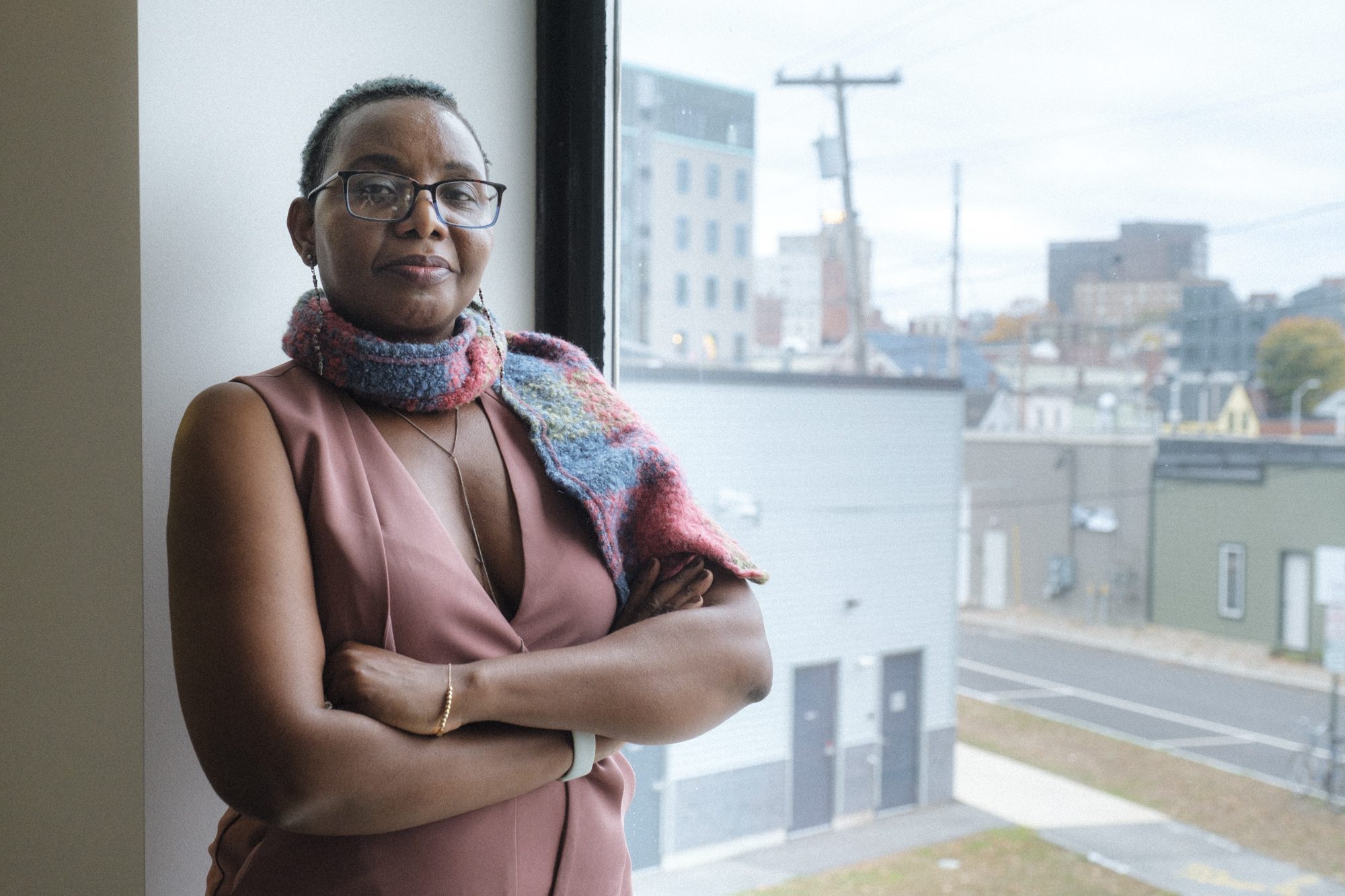
Chitam said she’s optimistic that protests over racial injustice are spurring important conversations, but that alone is not enough to fix a system that is fundamentally unbalanced. Until people in power are from diverse backgrounds, the inequality will continue, she said.
Chitam helped spearhead an effort with Good Shepherd this summer to redistribute money directly to groups in diverse communities. In total, more than 20 organizations received more than $200,000, according to Miale.
Part of the emphasis was on providing “culturally appropriate” food at pantries. Chitam said this is important because when families are sheltering in place, it’s comforting to cook their favorite meals.
The redistribution program was an important effort after it became clear that communities of color in Maine had more difficulty getting extra food assistance during the pandemic, said Miale, the Good Shepherd president.
“I don’t necessarily think (COVID-19) caused that (inequity), it’s more of (COVID-19) caused us to wake up to that,” Miale said. “It just put such a glaring lens on how people of color disproportionately have such higher rates of hunger than whites in Maine. And that we weren’t adequately meeting the needs of those communities and (COVID-19) just kind of woke us up to that.”
When it comes to issues for people of color, change means changing systems.”
— Mufalo Chitam, executive director of the Maine Immigrants’ Rights Coalition
Maine also had the nation’s worst COVID-19 racial disparity: Black Mainers contracted the virus at a rate 20 times that of white Mainers.
Years before COVID-19, multiple organizations within the New Mainer communities already were working to increase access to food through sustainable farming programs.
Since 2014, the Somali Bantu Community Association has provided farm land for families in the Lewiston-Auburn area to grow their own produce. The program, called Liberation Farms, increases access to food, promotes a healthy lifestyle and provides economic opportunity to a community that often has to rely on food stamps, said its executive director, Muhidin Libah. The program serves 200 families.
“When you only have $200 for a whole month, it’s really unlikely for you to show up at the healthy food aisle, so you just go for bulk where you can stretch the dollars you have,” Libah said. “People started growing their own food and their own food happens to be healthy food, so their overall health improved.”
Groups like Cultivating Community in Portland and Sustainable Livelihoods Relief Organization in Lewiston provide similar programs.
When the coronavirus shut down most programs and community activities, Libah said his organization implemented safety measures such as required masks and handwashing stations so the farming could continue through the summer.
And the program has plans to continue expanding: It is finalizing a 99-year lease for property in Wales, between Lewiston and Augusta.
“Many programs stopped because of (COVID-19),” Libah said. “The only program that is going even better than before is the farming program.”


